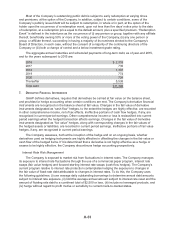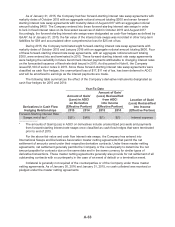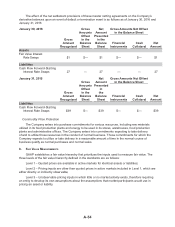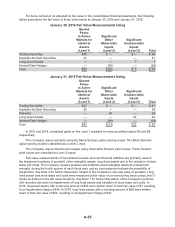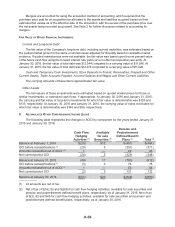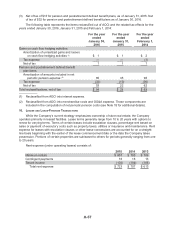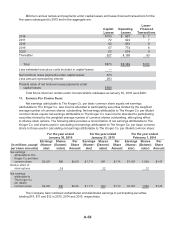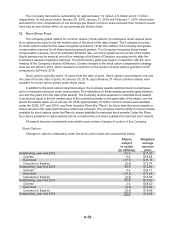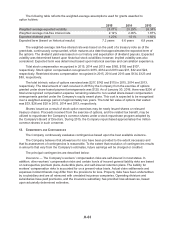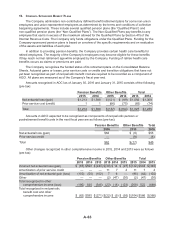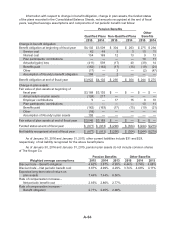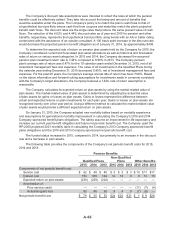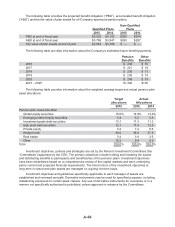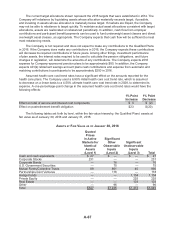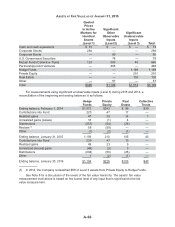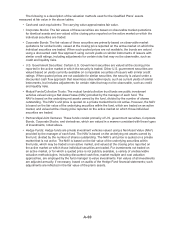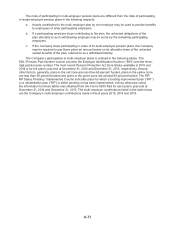Kroger 2015 Annual Report Download - page 135
Download and view the complete annual report
Please find page 135 of the 2015 Kroger annual report below. You can navigate through the pages in the report by either clicking on the pages listed below, or by using the keyword search tool below to find specific information within the annual report.
A-61
The following table reflects the weighted-average assumptions used for grants awarded to
option holders:
2015 2014 2013
Weighted average expected volatility 24.07% 25.29% 26.34%
Weighted average risk-free interest rate 2.12% 2.06% 1.87%
Expected dividend yield 1.20% 1.51% 1.82%
Expected term (based on historical results) 7.2 years 6.6 years 6.8 years
The weighted-average risk-free interest rate was based on the yield of a treasury note as of the
grant date, continuously compounded, which matures at a date that approximates the expected term of
the options. The dividend yield was based on our history and expectation of dividend payouts. Expected
volatility was determined based upon historical stock volatilities; however, implied volatility was also
considered. Expected term was determined based upon historical exercise and cancellation experience.
Total stock compensation recognized in 2015, 2014 and 2013 was $165, $155 and $107,
respectively. Stock option compensation recognized in 2015, 2014 and 2013 was $31, $32 and $24,
respectively. Restricted shares compensation recognized in 2015, 2014 and 2013 was $134, $123 and
$83, respectively.
The total intrinsic value of options exercised was $217, $142 and $115 in 2015, 2014 and 2013,
respectively. The total amount of cash received in 2015 by the Company from the exercise of options
granted under share-based payment arrangements was $120. As of January 30, 2016, there was $206 of
total unrecognized compensation expense remaining related to non-vested share-based compensation
arrangements granted under the Company’s equity award plans. This cost is expected to be recognized
over a weighted-average period of approximately two years. The total fair value of options that vested
was $33, $26 and $20 in 2015, 2014 and 2013, respectively.
Shares issued as a result of stock option exercises may be newly issued shares or reissued
treasury shares. Proceeds received from the exercise of options, and the related tax benefit, may be
utilized to repurchase the Company’s common shares under a stock repurchase program adopted by
the Company’s Board of Directors. During 2015, the Company repurchased approximately five million
common shares in such a manner.
13. COMMITMENTS AND CONTINGENCIES
The Company continuously evaluates contingencies based upon the best available evidence.
The Company believes that allowances for loss have been provided to the extent necessary and
that its assessment of contingencies is reasonable. To the extent that resolution of contingencies results
in amounts that vary from the Company’s estimates, future earnings will be charged or credited.
The principal contingencies are described below:
Insurance — The Company’s workers’ compensation risks are self-insured in most states. In
addition, other workers’ compensation risks and certain levels of insured general liability risks are based
on retrospective premium plans, deductible plans, and self-insured retention plans. The liability for
workers’ compensation risks is accounted for on a present value basis. Actual claim settlements and
expenses incident thereto may differ from the provisions for loss. Property risks have been underwritten
by a subsidiary and are all reinsured with unrelated insurance companies. Operating divisions and
subsidiaries have paid premiums, and the insurance subsidiary has provided loss allowances, based
upon actuarially determined estimates.


